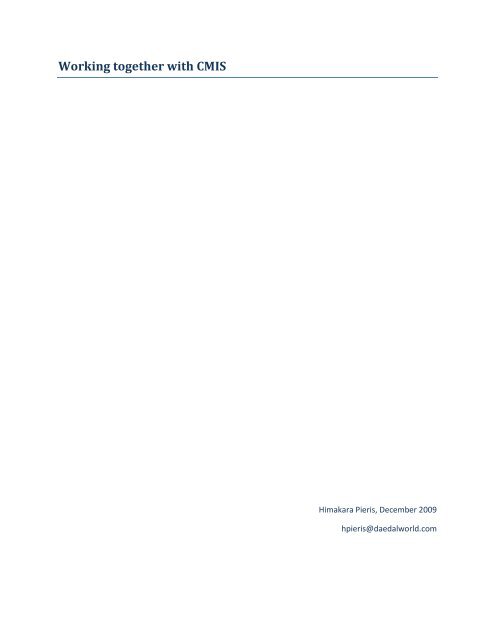Working together with CMIS - EMC Community Network
Working together with CMIS - EMC Community Network
Working together with CMIS - EMC Community Network
- No tags were found...
You also want an ePaper? Increase the reach of your titles
YUMPU automatically turns print PDFs into web optimized ePapers that Google loves.
<strong>Working</strong> <strong>together</strong> <strong>with</strong> <strong>CMIS</strong>Himakara Pieris, December 2009hpieris@daedalworld.com
OverviewMultiple content management systems <strong>with</strong>in the same organization have become a commonpractice, especially after SharePoint making a comeback two years ago. Content management systemsare sometimes separated at the department lines, function lines, and in certain other cases things arelittle more grey. Now more than ever, the important question is, can these systems work <strong>together</strong>,<strong>with</strong>out product specific plug-ins? Is there a third option, other than creating content silos throughvarious content management products, or paying for custom plug-ins? <strong>CMIS</strong> aims to be the solution.Content Management Interoperability Services or <strong>CMIS</strong> for short is a result of collaborativeeffort from major ECM vendors, including <strong>EMC</strong>, IBM, Microsoft, Alfresco, OpenText, etc. It is a standard,a technical specification developed through OASIS that describes an interface, any <strong>CMIS</strong> supporting ECMsystem should implement. While certain functionalities described in the specification must beimplemented by an ECM system in order be compliant, the others are optional. Specification aims toaddress the most common denominator of the ECM functionalities.<strong>CMIS</strong> provides a strongly typed object model, <strong>with</strong> four different types of objects (i.e.Document, Folder, Relationship and Policy). Two protocol binding options are provided, SOAP/WSDL forservice based binding and REST/Atom for resource based binding. Specification includes query support,type hierarchy/ inheritance support and document versioning support. Authentication is to be handledby the protocol. However, user’s level of access is governed by the repository.Challenges<strong>CMIS</strong> is not the first standard to enter ECM space. Any technology standard battles quite a fewchallenges during its making, these include: platform or technology bias, scope, lack of support and thecore differences among application platforms.Platform or Technology BiasA technology or platform bias could greatly hinder the adoption and growth of astandardization effort; this is especially true when the standard discusses interoperabilityamong products from different vendors. In the case of <strong>CMIS</strong>, it is interesting to notice, howleading vendors in the marketplace have come <strong>together</strong> to develop a technology specification<strong>with</strong>out any platform bias. <strong>CMIS</strong> doesn’t favor any technology platforms, integrationmechanisms are implemented using standard open technologies.ScopeIdentifying the scope properly is crucial. Limited scope would make the specification lesseffective, while a broader specification would render the standard too complex, affecting thebuy-in of the stake holders. <strong>CMIS</strong> addresses the challenge by aiming to support a very commonset of features. Specification provides two categories of features: mandatory and optional, asthe names imply a content management system must expose all mandatory features to be
















